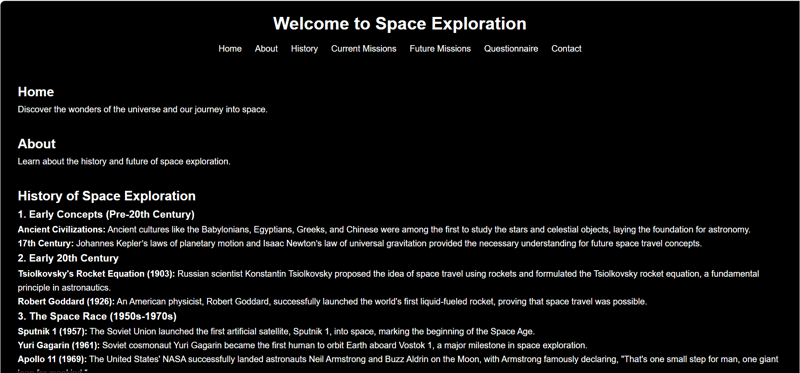Home
Discover the wonders of the universe and our journey into space.
About
Learn about the history and future of space exploration.
History of Space Exploration
1. Early Concepts (Pre-20th Century)
Ancient Civilizations: Ancient cultures like the Babylonians, Egyptians, Greeks, and Chinese were among the first to study the stars and celestial objects, laying the foundation for astronomy.
17th Century: Johannes Kepler’s laws of planetary motion and Isaac Newton’s law of universal gravitation provided the necessary understanding for future space travel concepts.
2. Early 20th Century
Tsiolkovsky's Rocket Equation (1903): Russian scientist Konstantin Tsiolkovsky proposed the idea of space travel using rockets and formulated the Tsiolkovsky rocket equation, a fundamental principle in astronautics.
Robert Goddard (1926): An American physicist, Robert Goddard, successfully launched the world's first liquid-fueled rocket, proving that space travel was possible.
3. The Space Race (1950s-1970s)
Sputnik 1 (1957): The Soviet Union launched the first artificial satellite, Sputnik 1, into space, marking the beginning of the Space Age.
Yuri Gagarin (1961): Soviet cosmonaut Yuri Gagarin became the first human to orbit Earth aboard Vostok 1, a major milestone in space exploration.
Apollo 11 (1969): The United States' NASA successfully landed astronauts Neil Armstrong and Buzz Aldrin on the Moon, with Armstrong famously declaring, "That's one small step for man, one giant leap for mankind."
4. Post-Moon Landings and the Space Shuttle Era (1970s-1990s)
Space Stations:
- Salyut and Mir (1971-1986): The Soviet Union launched a series of space stations, culminating in the long-lasting Mir, which operated until 2001.
- Skylab (1973): The United States launched its first space station, Skylab, which was operational for six years.
Space Shuttle Program (1981-2011): NASA’s reusable Space Shuttle fleet completed 135 missions over 30 years, including launching satellites, conducting scientific research, and assembling the International Space Station (ISS).
5. International Cooperation and Space Exploration (1990s-Present)
International Space Station (ISS) (1998-present): A joint effort by NASA, Roscosmos (Russia), ESA (Europe), JAXA (Japan), and other partners, the ISS serves as a hub for scientific research and international collaboration in low Earth orbit.
Mars Exploration:
- Rovers and Orbiters: The Mars rovers like Spirit, Opportunity, Curiosity, and Perseverance have provided detailed information about the Martian surface and its potential to support life.
- ExoMars (2020): A European-Russian mission designed to search for signs of life on Mars.
6. Private Space Exploration and the Future (2000s-Present)
Commercial Spaceflight: Companies like SpaceX, Blue Origin, and Virgin Galactic are pioneering commercial space travel, aiming to make space more accessible to private individuals and researchers.
Current Missions
Explore the ongoing missions that are expanding our understanding of the universe.
Future Missions
Learn about the upcoming missions that aim to push the boundaries of space exploration.
Questionnaire
Contact
Get in touch with us for more information about space exploration.


























